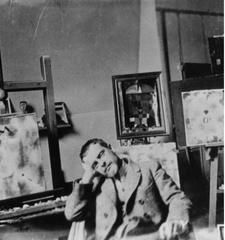



Münchner Blätter für Dichtung und Graphite
1967 Lithograph
#B1276
Sold
$0$795
Paul Klee (1879-1940)
July 31st, 1967
Lithograph on Paper
8.75"x11" unframed
Reproduced by E.W. Kornfeld Catalogue Raisonné Paul Klee - Graphic Works no. 73 -- Münchner Blätter für Dichtung und Graphite. Pencil notes along bottom. Good vintage condition with some paper discoloration around image area.
From the estate of Edyth and Phillip Bassett.
 Paul Klee was a Swiss-born artist and thinker, whose unique, humorous, and simplified style was deeply influenced by expressionism, cubism, and surrealism. He is notable for his contributions to color theory and the development of modernism through his writing and lectures, collated and entitled, Writings on Form and Design Theory (Schriften zur Form und Gestaltungslehre), published in English as the Paul Klee Notebooks.
Paul Klee was a Swiss-born artist and thinker, whose unique, humorous, and simplified style was deeply influenced by expressionism, cubism, and surrealism. He is notable for his contributions to color theory and the development of modernism through his writing and lectures, collated and entitled, Writings on Form and Design Theory (Schriften zur Form und Gestaltungslehre), published in English as the Paul Klee Notebooks.
In 1898, he began studying at the Academy of Fine Arts in Munich. By 1905, he had developed signature techniques, including drawing with a needle on a blackened pane of glass. Between 1903 and 1905, he completed a set of etchings called Inventions that would be his first exhibited works. In 1910, he had his first solo exhibition in Bern, which subsequently traveled to three Swiss cities.
Klee taught at the Bauhaus from 1921 to 1931, alongside his friend and fellow artist Wassily Kandinsky. In 1923, Kandinsky and Klee formed the Blue Four with two other artists, Alexej von Jawlensky and Lyonel Feininger, and toured the United States to lecture and exhibit work. Klee had his first exhibits in Paris around this time, finding favor with the French surrealists. He began teaching at Dusseldorf Academy in 1931. Two years later, he was fired under Nazi rule. The Klee family moved to Switzerland in late 1933. Klee was at the peak of his creative output during this tumultuous period. He produced nearly 500 works in a single year and created Ad Parnassum, widely considered to be his masterpiece.
View The Legends of Modern Art Collection & Read the Bassett Family Story
July 31st, 1967
Lithograph on Paper
8.75"x11" unframed
Reproduced by E.W. Kornfeld Catalogue Raisonné Paul Klee - Graphic Works no. 73 -- Münchner Blätter für Dichtung und Graphite. Pencil notes along bottom. Good vintage condition with some paper discoloration around image area.
From the estate of Edyth and Phillip Bassett.

In 1898, he began studying at the Academy of Fine Arts in Munich. By 1905, he had developed signature techniques, including drawing with a needle on a blackened pane of glass. Between 1903 and 1905, he completed a set of etchings called Inventions that would be his first exhibited works. In 1910, he had his first solo exhibition in Bern, which subsequently traveled to three Swiss cities.
Klee taught at the Bauhaus from 1921 to 1931, alongside his friend and fellow artist Wassily Kandinsky. In 1923, Kandinsky and Klee formed the Blue Four with two other artists, Alexej von Jawlensky and Lyonel Feininger, and toured the United States to lecture and exhibit work. Klee had his first exhibits in Paris around this time, finding favor with the French surrealists. He began teaching at Dusseldorf Academy in 1931. Two years later, he was fired under Nazi rule. The Klee family moved to Switzerland in late 1933. Klee was at the peak of his creative output during this tumultuous period. He produced nearly 500 works in a single year and created Ad Parnassum, widely considered to be his masterpiece.
View The Legends of Modern Art Collection & Read the Bassett Family Story




